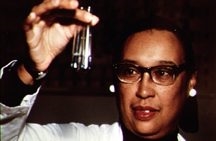 |
| Audrey Penn Deputy Director NINDS |
Audrey Penn, deputy director of the National Institute of Neurological Disorders and Stroke (NINDS), is driven by both intellectual curiosity and a love of people. Fortunately for her, she's been able to combine these two passions over her distinguished career in research and the treatment of people with neurological disorders.
“Science is marvelous,” she says. “If you are fortunate enough to find a teacher who turns you on to science, it can really take hold of you.” As a high school student growing up in New York City in the late 1940s, this happened to Penn. Science took hold of her, and it never let go.
After high school, she attended Swarthmore College in Swarthmore, Pa., where she majored in chemistry. But she found she wanted a career that gave her more human contact. “I realized that chemistry didn’t have as much to do with people as I wanted,” says Penn. “So I applied to medical school.” She enrolled at Columbia University’s College of Physicians and Surgeons in New York City in 1956.
 |
| Audrey Penn confers with a colleague |
Penn, an African American, began medical school at a time when few women or minorities became doctors. “My medical school class was only 10 percent female, and there were only one or two other minorities,” says Penn. “But I was fortunate. There were so few people like me, I didn’t get much flak.”
Nevertheless, Penn learned a valuable lesson. “When training to be a doctor, you have to learn to get along with people, whether you like it or not. There are all kinds of stories of how people in medical school don’t get along with each other. But learning how to work with people is part of the training. Science and medicine both are really about people.”
After completing her basic medical training, she decided to specialize in neurology. “I chose neurology because there was so much wonderful information to learn about the brain and everything connected to it,” says Penn. “When I started out, you couldn’t image the brain or examine cells in culture, like you can today. Nevertheless, it was absolutely wonderful stuff.”
In fact, the intellectual challenges of neurology research proved irresistible. “There were such great opportunities in research,” says Penn. “That was what was left of the chemist in me. I really wanted to find out the ‘why’ behind some of these neurological disorders. I had the intellectual curiosity, and these sorts of studies were really starting to take off.”
 |
| Audrey Penn in her lab at the University of Pennsylvania |
For the next 20 years, Penn devoted herself to studying diseases that affect muscle control. She started out at the University of Pennsylvania, then wound up back at the College of Physicians and Surgeons—this time as a professor—where she became famous for her work on myasthenia gravis. This disease affects more than 25,000 people in the United States.
The primary symptom of myasthenia gravis is muscle weakness that tends to get worse as time passes and can seriously impair day-to-day living. In most cases, the disease is caused when a person’s own immune system attacks the nervous system. Specifically, the immune cells destroy acetylcholine receptors, proteins that bind the neurotransmitter acteylcholine at the spot where nerves and muscles meet. Acetylcholine is a molecule that stimulates muscles to contract. Without acetylcholine receptors to receive the signal from the nervous system, muscles don’t get the message that it’s time to move.
Penn’s studies made a major contribution to understanding how an arthritis drug called penicillamine can trigger an immune attack that can lead to myasthenia gravis. She has also helped clarify the role of the thymus gland in myasthenia gravis. In particular, her clinical studies confirmed that removing the thymus can essentially cure the disease in almost two-thirds of patients.
Since 1996, Penn has served as deputy director of NINDS, part of the National Institutes of Health in Bethesda, Md. Penn says she loves her job because of the variety it entails. “My job goes all the way from making policy regarding finding the causes of neurological disorders, to training new neurologists and scientists, to dealing with patients and the general public,” she says. “We try to look down the road and make predictions about what will work in solving the problems of people with neurological disorders.”
Penn encourages anyone interested in science to consider a career in medicine. “If you are interested in science and medicine, then do it,” she says. “It’s not going to be easy. But there is a lot of exciting research out there to be done, with many opportunities in all areas of science and medicine. You just have to get out there and learn about it.”
Page created on 3/27/2012 1:21:33 PM
Last edited 1/9/2017 9:33:28 PM
